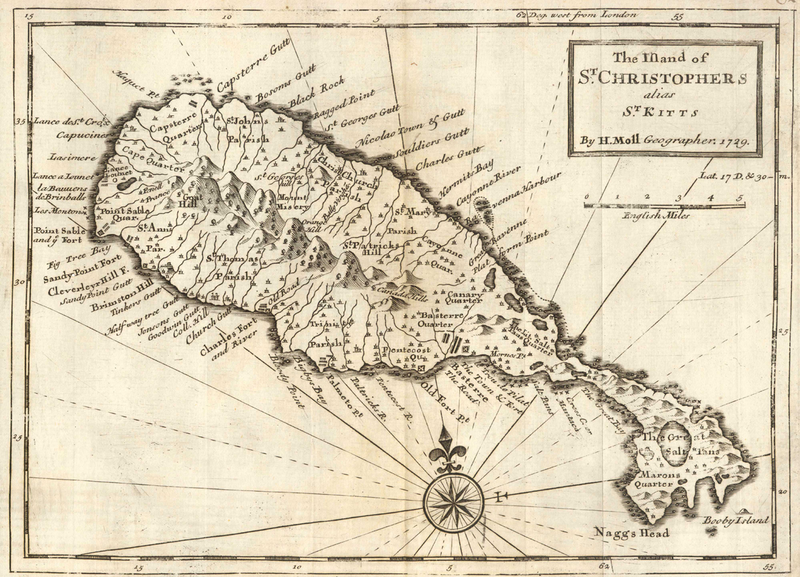 In 1493, Christopher Columbus led the first European exploration of the islands located where the Caribbean Sea meets the Atlantic Ocean. He named each of the islands of the Lesser Antilles including one which he dubbed San Jorge ("Saint George"). Later explorers misinterpreted Columbus' charts and the island became known as San Cristobal ("Saint Christopher") or, more commonly, Saint Kitts.
In 1493, Christopher Columbus led the first European exploration of the islands located where the Caribbean Sea meets the Atlantic Ocean. He named each of the islands of the Lesser Antilles including one which he dubbed San Jorge ("Saint George"). Later explorers misinterpreted Columbus' charts and the island became known as San Cristobal ("Saint Christopher") or, more commonly, Saint Kitts.In the sixteenth century, French Huguenots refugees founded a colony on the island, naming it after their home-town: Dieppe. Only months after its establishment, the Spanish raided the settlement and deported all its inhabitants. The next attempt to colonise the island did not occur until the next century with the arrival of the English under Thomas Warner.
Warner was the son of a Suffolk landowner and former captain in the bodyguard of King James I and lieutenant of the Tower of London. In 1620 he set off with Captain Roger North to help found a colony in Guiana, but James revoked their charter and recalled North, to placate the Spanish, leaving the colonists to fend for themselves. In the meantime, Warner had met Thomas Painton who suggested that he found a colony on St Kitts or another of the smaller Caribbean islands.
Warner returned to England to find support for this venture. In 1623 he set off with his family and fourteen other colonists for Virginia, from where they sailed for the Lesser Antilles. The group arrived on St Kitts on 28th January 1624. Undaunted by initial setbacks - a hurricane destroyed their first tobacco crop and many of their houses - the settlement grew and in September 1625, Warner transported their first tobacco crop back to England. While in England, Warner received letter patent from James' recognising the colony and giving it Royal protection. Warner also received the title of lieutenant of St Kitts (or 'Merwar's Hope' as it was called in the document, referring to himself and one of the major investors, the London merchant Ralph Merifield), Nevis, Barbados, and Montserrat.
He secured more investment and returned to the colony with around one-hundred more settlers and sixty slaves. When he arrived he found that the French had also established a colony on the island. The colonists had welcomed the French probably because they offered mutual protection against the local Carib population should they attack.
As it was, the Europeans made a pre-emptive strike against the Caribs, killing their King, taking a number of the women as slaves, and driving the rest of the survivors from the island. In 1627, the English and French then concluded a treaty formalising their mutual protection pact against both the Caribs and the Spanish. The terms of the treaty also divided the island between the two groups, with the English taking the territory middle and the French occupying either end.
Related posts
The Great Hurricane: 10th October 1780
Caribbean immigrants arrive on the Empire Windrush: 22nd June 1948
Emperor Haile Selassie visited Jamaica: 21st April 1966

No comments:
Post a Comment